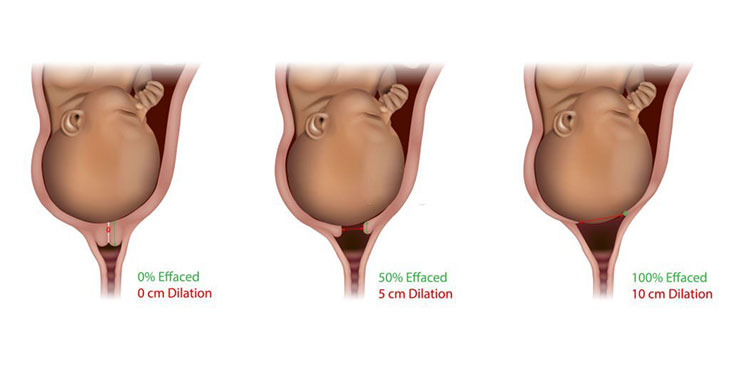What to do when labour pains start? Every new mom must have had the identical experience struggling with the same questions.
Well, worry no more since I’m here to get your back. Find out more here about what to prepare and when to get ready!
What Is Labour?

Labor, so-called childbirth, is the course of a baby exiting from the uterus, known as the womb.
Whenever a mom senses some changes in her cervix with the coming of frequent contractions, she knows that is how her labor pain starts.
But what exactly are these contractions? How can you be aware of them? This is the process of your uterine muscles contracting and then relaxing.
Such motions will aid in ejecting your unborn child from the womb.
Labor also occurs with the uterine cervix, located at the top of the vagina, opening to the uterus.
The more disclosed it is, the faster the baby can get out of the new mom. This occurrence is also referred to as cervical dilation.
Signs Of Labor
You might start to experience a few modest physical labor indicators as the delivery day approaches. Here are some signs to know whether it is the time coming near!
Strong, Frequent Contractions
As I mentioned before, frequent, strong contractions are one of the most transparent indications of the due date coming in.
When the mother is actually in labor, her uterus muscle movement will be filled with tightening and shrinking sensations to help deliver the child.
There are chances it takes from 30 to 70 seconds for each contraction to happen and 5 to 10 minutes apart for it to repeat.
Many can’t even move or talk as these intense breaks take place. The closer you get to labor, the stronger they grow.
Bloody Show
The deficit of the mucus plug is the next sign you should give heed to.
This cork securing our uterus from the outer world may burst into one big piece or several smaller ones and resembles nasal mucus without you even perceiving its appearance.
There is a high likelihood that many women don’t get their chance to lose it before the due date.
This normally occurs with a spike in thickening of the pinkish vaginal discharge like blood clots, the so-called bloody show, in the final days prior to the birth delivery.
Belly And Lower Back Pain
Another indication of labor is the mother’s stomach feeling unsettled with the pressure from the lower abdominal area.
The suffering also comes as severe menstrual cramps and lower back pain that could even travel to the legs. Worse yet, the discomfort won’t go anywhere even if you modify your stance.
Water Breaking
Without a doubt, water breaking is the most familiar sign of labor that even one who has never learned more about childbirth before could acknowledge.
However, it is not the only indication the mother can experience during her labor latent phase; most tend to undergo these ruptured membranes and amniotic fluid leakage after other signs have arrived.
Water breaking can also present itself in many ways. Several won’t experience all of the loss at once but seem more like a trickle instead.
What To Do When Labour Pains Start? 10 Tips For You!

You should time the contractions, stay hydrated and relaxed, take a warm bath, or turn to painkillers. Also, keep in touch with your doctor and tell him about your state.
Time The Contractions
What to do when labor pains start? Timing the contractions may somehow sound unnecessary but are indeed a beneficial act during your labor.
This will help you distinguish whether you are experiencing real or fake contractions.
As such, the ones associated with fake labor will most likely stop when you move, weaker, more erratic, and not become more frequent over time.
In contrast, the real ones will be more continuous, longer, and won’t stop even if your position is shifted or switched.
Stay In Communication
I understand that women might find it too painful during labor to listen or make coherent language. Despite that, halting communication is never a good idea.
This is because not only making eye contact or having a light touch can help the mother be more relaxed, but it can also help her support person address her demands better and give her in-time assistance.
Change Positions
It is advised by specialists to utilize gravity’s force to promote the rotation and movement of the baby down into the mother’s pelvic canal.
That is why laboring while swaying, shifting, walking postures, or rolling on the birthing ball cannot only aid in unwinding the new mom’s mind and reduce her discomfort but also speed up the delivery process.
Practice Relaxation Techniques
A positive delivery experience may result from your preparation, which may include looking into relaxation methods to assist you in coping with your painful contraction pains during labor.
You can kick off by getting your facial and head muscles released. Let go of the tension across the abdomen, back, and across shoulders, down the legs, and finally reach the toes.
It can also help with some breathing techniques to slowly exhale and consider a soothing touch.
Take Warm Showers Or Baths
When it comes to what to do when labour pains start, bathing in warm water while laboring can be highly useful in providing ease and reducing discomfort.
This is because water offers endorsement and buoyancy, allowing laboring women to unwind and enjoy the weightlessness it imparts.
Stay Hydrated And Nourished
If you’ve ever participated in an endurance race or casual run, you are aware of how the preparations in terms of hydration are crucial for this tough physical activity.
The truth is that your body needs all of these elements to function properly while you are giving birth. It’s the same as any other sporting competition!
It is our responsibility to provide our body with the necessary hydration and nutrition for it to function at its best.
Create A Soothing Environment
Another way to reduce the mother’s anxiety and suffering is to find a birthing setting that is cozy and comfortable for her not to be affected by any disturbing elements.
A soothing environment such as the one that has room for the mother to roam around and take a bath would also be one of the best ways on how to deal with labor pains at home.
It would be even better if the place featured a range of furnishings and equipment like a birthing ball, a rocking rocker, a soft bed, or a squatting bar to promote activity and alleviate discomfort.
Use Pain Relief Options
How to prevent labor pain?
Pain medication such as nitrous oxide can make this stage of labor and delivery much easier for you to handle.
It works by numbing the pathways of nerves that channel pain signals all the way from the birth canal of birth to the central nervous system.
A heads-up: You shouldn’t get sick or feel sleepy from it. An epidural typically provides total pain relief. If your labor is protracted or very painful, it might be useful.
Continue To Time Contractions
At this point, with all of the chaos and restlessness in the scene, many may fail to remember timing uterine contractions.
Yet, you should ask your support person, husband, or your midwife beforehand to do the task for you.
Bear in mind that the more the doctor knows about the time you start being in labor, the more your health care provider can help you through this great deal of birth delivery!
Trust Your Instincts
My final advice is to trust your maternal instinct no matter what. Let’s give it a thought: Who else can try her best to protect her baby at all costs better than the mother herself?
So as long as you have faith in your strength and give it the best shot possible, I’ll say there’s not much to worry about!
FAQs

What Are The Alternative Methods Of Labor Pain Relief?
The most popular form of pain treatment utilized during childbirth in the US is an epidural block, sometimes known as “an epidural.”
Besides, you also have a lot of other non-medical pain-relieving options at your disposal.
These include exercising throughout the active labor, using heat packs or massages, submerging oneself in water, practicing relaxation techniques, self-hypnosis, aromatherapy, acupuncture, and other practices.
Who Will Be With Me During Labour?
When you deliver birth in any birthing center, your birth partner and other specialized healthcare providers, including midwives, will take care of you.
Whoever you decide to bring along should be completely dependable, supportive, an unwavering supporter, and one who won’t react negatively to seeing blood or other unsavory fluids from your body or functions that may occur during birth.
When Should I Ring The Hospital Or Midwife?
If you believe you are in labor, call the healthcare facility or your midwife right away. Over the phone, you’ll probably receive a preliminary evaluation.
Conclusion
Now, you’ve known what to do when labour pains start; I guess either the mother or her husband is mostly there near the process.
If that’s the case, it is unavoidable to be scared and filled with stress, but don’t let it stretch your mind too much.
Again, the key is careful material birth plan and mental preparation. As long as you have them, there’s not much reason to put further pressure on your shoulder!
Hopefully, our article can be of great help to you somehow. See then!
